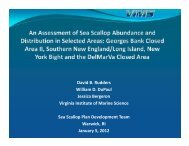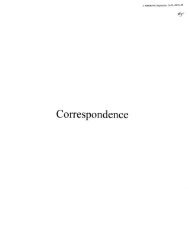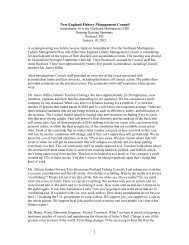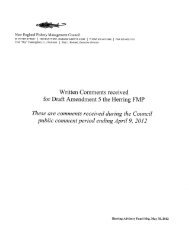Smooth Bottom Net Trawl Fishing Gear Effect on - New England ...
Smooth Bottom Net Trawl Fishing Gear Effect on - New England ...
Smooth Bottom Net Trawl Fishing Gear Effect on - New England ...
Create successful ePaper yourself
Turn your PDF publications into a flip-book with our unique Google optimized e-Paper software.
successi<strong>on</strong>al stage reflecting the l<strong>on</strong>g term ambient disturbance frequency. An inspecti<strong>on</strong> of the<br />
benthic species list reveals that two of the faunal dominants (Pri<strong>on</strong>ospio steenstrupi and Unciola<br />
inermis) are important food items for bottom fish and that overall faunal density is slightly<br />
higher in the trawled lanes than in the c<strong>on</strong>trols. What if the trawling frequency was doubled or<br />
tripled? Would this frequency of “pulsing” be accompanied by enhanced productivity of both<br />
the invertebrate prey species and increased net catch?<br />
4.4 A Modeling/Simulati<strong>on</strong> Approach<br />
Field experiments involving manipulated pulsed disturbances and associated ground-truth<br />
sampling can be very expensive. For this reas<strong>on</strong>, we recommend that before such a field effort is<br />
made, modeling/simulati<strong>on</strong> studies be c<strong>on</strong>ducted to provide insight into the pulse frequency to<br />
maintain or optimize sec<strong>on</strong>dary benthic productivity. Examples of such modeling exercises are<br />
given in McCall (1975, 1977), Rhoads, McCall, and Yingst (1978), Whitlach, Lohrer, and<br />
Thrush (2003), and Zajac (2001). This type of modeling is based <strong>on</strong> knowledge of the dominant<br />
col<strong>on</strong>izing species life history attributes, literature values for known recol<strong>on</strong>izati<strong>on</strong> rates, and<br />
seas<strong>on</strong>al affects <strong>on</strong> somatic/populati<strong>on</strong> growth rates and recruitment.<br />
We suggest that the STELLA graphical program used by Whitlach, Lohrer, and Thrush (2003) to<br />
simulate the recovery time for benthic systems col<strong>on</strong>ized by larval and n<strong>on</strong>-larval recruitment<br />
may serve as a platform for the modeling and simulati<strong>on</strong> proposed here. Some additi<strong>on</strong>s and<br />
rec<strong>on</strong>figurati<strong>on</strong>s would be required in their STELLA program to address the critical trawling<br />
frequency problem. The model (or family of models) would need to address a wide range of<br />
management scenarios. For example, the simulati<strong>on</strong> should be sensitive to the targeted fish<br />
populati<strong>on</strong> (s) and hence the preferred benthic prey species eaten by the fish populati<strong>on</strong>s interest.<br />
The input variables to the simulati<strong>on</strong>s would include how frequently the system is impacted by<br />
natural disturbances known to be important in restructuring the benthos such as storm reworking,<br />
seas<strong>on</strong>al hypoxia, or major fluctuati<strong>on</strong>s in salinity. The resp<strong>on</strong>se of benthic prey to such<br />
disturbances will also depend <strong>on</strong> the candidate species pool that can populate the site. This<br />
includes the method and frequency of each species’ mode of reproducti<strong>on</strong>, dispersal, and<br />
fecundity. Finally, the model must c<strong>on</strong>sider the effect of seas<strong>on</strong>al water temperatures and<br />
primary producti<strong>on</strong> cycles that drive recruitment and growth.<br />
For this initial modeling effort, we suggest that the simulati<strong>on</strong> be run for two sites representing<br />
end members in terms of ambient disturbance. The first would be Little Tow/Mud Hole<br />
representing a naturally disturbed bottom (seas<strong>on</strong>al storm induced bed load transport). This<br />
simulati<strong>on</strong> will rely <strong>on</strong> data already in hand in our 2001 and 2002 trawling impact studies. A<br />
sec<strong>on</strong>d simulati<strong>on</strong> would be run representing a low kinetic energy site in Massachusetts Bay (off<br />
Gloucester per Alan Michael’s suggesti<strong>on</strong> or a high successi<strong>on</strong>al stage mud site in central Mass<br />
Bay where several years data from the MWRA study is available). The two simulati<strong>on</strong>s would<br />
provide insight into the critical pulse disturbance in areas naturally affected by storm reworking<br />
(Little Tow and Mud Hole) versus a low kinetic energy bottom which is maintained in a high<br />
order successi<strong>on</strong>al stage. Seas<strong>on</strong>ality factors would be able to be held c<strong>on</strong>stant given the<br />
proximity of the two sites.<br />
The product of such a modeling exercise would be bivariate graphs of disturbance frequency<br />
versus sec<strong>on</strong>dary productivity over an annual cycle for both sites. Based <strong>on</strong> this simulati<strong>on</strong><br />
64







